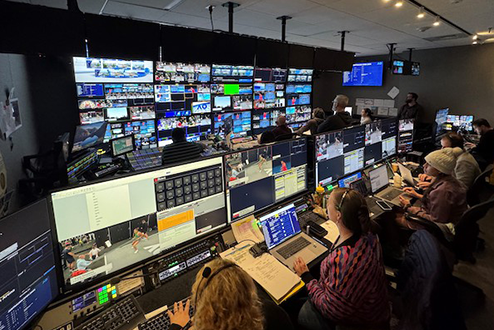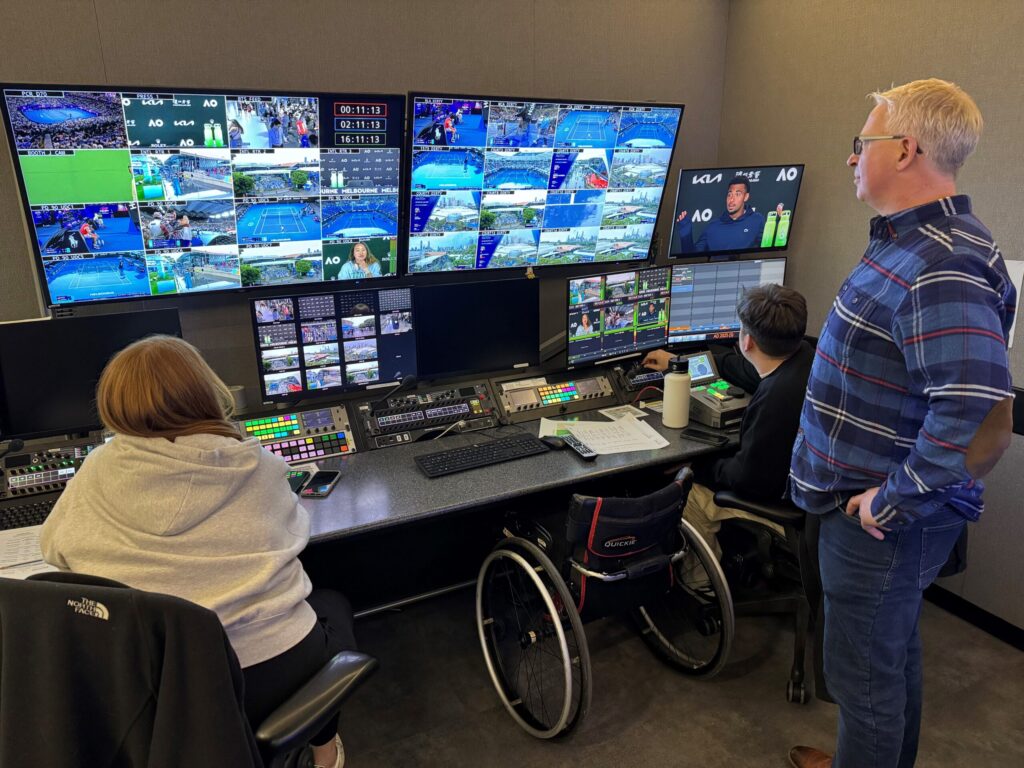Operation comprises staff in Melbourne, cloud editing in London, REMI team in Bristol
ESPN’s Australian Open production shifted into high gear on Saturday. The effort spans the globe: Staff are onsite in Melbourne. A cloud-based edit team is working from London. A REMI team supports production from Bristol, CT. The Bristol team supports both the domestic and ESPN International efforts, which also include personnel in Argentina, Brazil, and Mexico.
“It has been nice to work our way back from the pandemic and have a presence in Melbourne,” says Larry Wilson, senior manager, remote operations, ESPN, “but there are efficiencies in doing it this way as we have found a balance. The REMI team has been incredibly supportive and creative in being able to produce such high-quality content for us over the years.”
REMI Production Powers ESPN’s Global Coverage
For the ESPN REMI team, the event stands alone on the yearly calendar. It’s the biggest yearly production that requires a new sleep schedule: on-air days can run from 9 p.m. ET to 9 a.m. or even 10 a.m.

The odd hours also make the event unique for the REMI teams not working in Melbourne. Notes Scott Chamberland, supervisor, REMI operations, ESPN, “The individuals crewed in Bristol flip their life schedule for a month to make this project happen.”
Mike McQuade, EVP, sports production, ESPN, says the folks on the team are thrilled to be in Melbourne to “showcase world-class tennis to fans around the globe and the vibrant culture Down Under. Our incredibly talented team is uniquely qualified to navigate the challenges that come with creating and distributing content across a multitude of platforms and countries — some 10,000 miles apart — over nearly three weeks.”
During those three weeks, the ESPN team in Bristol works from Production Control Room D70. All domestic coverage is produced there before the signals are sent to master control. Additional Bristol facilities include a production-support space, voiceover booth for International, and two tape rooms equipped with Evertz DreamCatchers. The tape rooms record all feeds coming in from Melbourne and share content through a connected network.
“Right now,” McQuade adds, “we’re staffing 24 techs just from the REMI group alone daily, and they support our ESPN domestic and international footprint. As the tournament plays on, we will start getting clean camera feeds and integrating them into the production. As the tournament play moves into the second week, our crews will shrink.”
According to Wilson, 41 outbound transmission paths from Melbourne include 16 court feeds, press conferences, and other behind-the-scenes content. Each path runs through frame converters to change the frame rate from 50p to 59.94. “Three of those 41 feeds,” he explains, “are solely for the ESPN International side, which can take whatever content they want for their purposes and audiences.”
Cloud Editing and International Integration
New this year is the use of the cloud for editing. Postproduction company CMSI provides infrastructure supporting a remote edit that is based in the UK and cloud-connected to feature producers in Chicago and North Carolina. “The producers have their own interface to view the cloud-based work,” Wilson explains. “All the editing is happening in the cloud, allowing the producers to log in and watch the progress and check things out before it is sent to Bristol for integration.”
An International Effort
London isn’t the only international location for Australian Open operations. ESPN International staffers in Argentina, Brazil, Mexico, and Canada work to serve their viewers. Chris Calcagno, coordinating producer II at ESPN International/ESPN Deportes, says the team in Buenos Aires connects two ESPN International control rooms to Bristol. A smaller control room in Bristol coordinates all the feeds. The team then sends them to platforms in Argentina, Brazil, and Canada.

“We have a big facility in Buenos Aires,” he says, “where we put together the Spanish feeds for two simultaneous networks for the first eight days of the tournament. Many of the talent are based in Buenos Aires, but we also have talent in Bristol and Mexico as well as a reporter at the Open, who gets interviews. But everything gets incorporated in Buenos Aires for the Spanish-language side of things.”
ESPN Brazil operates two control rooms during the first eight days. A reporter in Melbourne supports the Portuguese broadcast. A TSN control room creates a channel for Canadian viewers.
“ESPN International has a studio at the Australian Open so we can do interviews,” says Calcagno, adding, “It is also connected to Buenos Aires, Sao Paulo, Mexico City, and Toronto.”
Tennis Australia will drive innovation over the next two weeks. ESPN’s global team is eager to deliver it and help launch the 2025 tennis-major season.
“The people who participate on this love tennis and love being part of this team,” says Chamberland. “This is my fifth year. Now I’m in a management role, so it’s cool to see it from a different perspective. But we have the buy-in from everybody who participates, and that makes the end product that much better.”
Source : Sports Video Group












